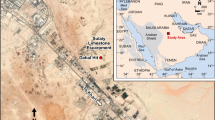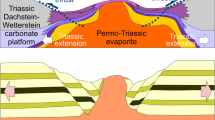Abstract
Palaeoenvironment of late Proterozoic carbonate deposits of Vindhyan basin of central India has been studied using lithofacies analysis, petrographical character and sediment dispersal patterns. Based on field parameters, 12 lithofacies were identified from five sections. For environmental interpretation, these lithofacies have been grouped into two major lithofacies associations namely a lower association A comprising reefal lithofacies, algal lithofacies, oolitic-intraclastic lithofacies, stromatolitic limestone lithofacies and an upper lithofacies association B, which includes nodular limestone lithofacies, large-scale planar cross-bedded lithofacies, parallel and ripple cross-laminated lithofacies, lenticular and flaser bedded lithofacies, shaly limestone lithofacies, synaeresis cracked lithofacies, deformed limestone lithofacies and finally, channelized and sandy limestone lithofacies. Reefal lithofacies and oolitic-intraclastic lithofacies were deposited under subtidal conditions. Synaeresis cracked lithofacies, lenticular and flaser bedded lithofacies, channelized and sandy limestone lithofacies were deposited under intertidal conditions whereas stromatolitic limestone lithofacies deposition ranged between subtidal to intertidal domains. Lithofacies character of the rock succession as well as the microfacies associations recognized petrographically indicate that the depositional environment belongs to platform interior with restricted circulation to marginal sand shoals in a carbonate ramp setting. Due to calcium-carbonate-saturated water, the diagenesis took place in stagnant marine phreatic environment where little compaction occurred, with abundant micrite as primary groundmass, and rapid cementation by calcite took place. With palaeocurrent current direction towards south and azimuthal dispersion of 270°, a pattern akin to a marine system is corroborated.








Similar content being viewed by others
References
Adnan A, Shukla UK. A case of normal regression with sea level transgression: example from the Ganurgarh Shale, Vindhyan Basin, Maihar (M.P.), India. J Geol Soc India (In press)
Akhtar K (1976) Facies analysis and depositional environments of the Bhander Limestone (Precambrian), southeastern Rajasthan and adjoining Madhya Pradesh, India. Sediment Geol 16:299–318
Anderson EJ, Goodwin PW, Sinclair CJ (2003) Facies and paleoenvironments of the Keyser Formation in the context of its cyclic structure, In: Way JH et al. (eds) Geology on the edge: selected geology of Bedford, Blair, Cambria, and Somerset Counties, Guidebook, 68th Annual Field Conference of Pennsylvania Geologists, Altoona, PA 1-18
Anderton R (1976) Tidal-shelf sedimentation: an example from the Scottish Dalradian. Sedimentology 23:429–458
Auden JB (1933) Vindhyan sedimentation in the Son Valley, Mirzapur district. Mem Geol Soc India 62(2):141–250
Banerjee I (1974) Barrier-coastline sedimentation model and the Vindhyan example. Quart J Geol Min Met Soc India, Golden Jubilee 46:101–127
Banerjee S, Dutta S, Paikaray S, Mann U (2006) Stratigraphy, sedimentology and bulk organic geochemistry of black shales from the Proterozoic Vindhyan Supergroup (Central India). J Earth Syst Sci 115(1):37–47
Beukes NJ, Lowe DR (1989) Environmental control on diverse stromatolite morphologies in the 3000 m.yr. Pongola Supergroup S Afr Sedimentol 36:383–397
Bhardwaj BD (1973) Petrography and environmental significance of Bhander Limestone (upper Vindhyan) in Kota-Rawatbhata area, Rajasthan. J Geol Soc India 14(1):89–95
Bhattacharyya A (1993) A field guide on the Upper Vindhyans of Maihar, Satna district, Madhya Pradesh. Geol Soc India
Bhattacharyya A, Chanda SK, Bose PK (1986) Upper Vindhyans of Maihar: a field guide. Published by Department of Geological Sciences, Jadavpur University, Calcutta 1-19
Calvet F, Tucker ME, Henton JM (1990) Middle Triassic carbonate ramp systems in the Catalan Basin, northeast Spain: facies, system tracts, sequences and controls. In: Tucker, ME, Wilson, JL et al. (eds) Carbonate platforms: facies, sequences and evolution. Special Publication. The International Association of Sedimentologists 9: 79–108
Chakraborti R, Basu AR, Chakraborty A (2007) Trace element and Nd-isotopic evidence for sediment sources in the mid-Proterozoic Vindhyan Basin, central India. Precambrian Res 159:260–274
Chakraborty PP (2004) Facies architecture and sequence development in a Neoproterozoic carbonate ramp: Lakheri Limestone Member, Vindhyan Supergroup, Central India. Precambrian Res 132:29–53
Chakraborty C (2006) Proterozoic intracontinental basin: the Vindhyan example. J Earth Syst Sci 115(1):3–22
Chakraborty PP (2011) Slides, soft-sediment deformations, and mass flows from Proterozoic Lakheri Limestone Formation, Vindhyan Supergroup, central India, and their implications towards basin tectonics. Facies 57:331–349
Chakraborty PP, Sarkar S, Bhattacharya SK, Sanyal P (2002) Isotopic and sedimentological clues to productivity change in Late Riphean sea: a case study from two intracratonic basins of India. Proc Indian Acad Sci (Earth Planet Sci) 111:379–390
Chakraborty PP, Dey S, Mohanty SP (2010) Proterozoic platform sequences of peninsular India: implications towards basin evolution and supercontinent assembly. J Asian Earth Sci 39:589–607
Chanda SK, Bhattacharya A (1982) Vindhyan sedimentation and palaeogeography: post Auden development. In: Valdiya, KS, Bhatia, SB, Gaur, VK (eds) Geology of Vindhyachal. Hindustan Publishing Corporation, pp 88–101
Chaudhuri AK, Mukhopadhyay J, Deb SP, Chanda SK (1999) The Neoproterozoic cratonic successions of peninsular India. Gondwana Res 2(2):213–225
Choquette PW, Pray L (1970) Geologic nomenclature and classification of porosity in sedimentary carbonates. AAPG Bull 54:207–250
Curray JR (1956) The analysis of two-dimensional orientation data. J Geol 64:117–131
Davis RA, Dalrymple RW (2012) Principles of tidal sedimentology. Springer, New York
De Boer PL (1979) Convolute lamination in modern sands of the estuary of the Oosterschelde, The Netherlands, formed as a result of entrapped air. Sedimentology 26:283–294
De Boer PL, Oost AP, Visser MJ (1989) The diurnal inequality of the tide as a parameter for recognizing tidal influences. J Sediment Petrol 59:912–921
Donovan RN, Foster RJ (1972) Subaqueous shrinkage cracks from the Caithness Flagstone Series (Middle Devonian) of Northeast Scotland. J Sediment Petrol 42:309–317
Dunham RJ (1970) Stratigraphic reefs versus ecologic reefs. Am Assoc Petrol Geol Bull 54:1931–1932
Flügel E (2010) Microfacies of carbonate rocks, 2nd edn. Springer-Verlag, Berlin
Glumac B, Walker KR (2000) Carbonate deposition and sequence stratigraphy of the terminal Cambrian grand cycle in the southern Appalachians, USA. J Sed Res 70(4):952–963
Gopalan K, Kumar A, Kumar S, Vijayagopal B (2013) Depositional history of the Upper Vindhyan succession, central India: time constraints from Pb–Pb isochron ages of its carbonate components. Precambrian Res 233:108–117
Grotzinger JP (1986) Cyclicity and palaeoenvironmental dynamics, Rocknest Platform, northwest Canada. Geol Soc Am Bull 97:1208–1231
Grotzinger JP (1989) Facies and evolution of Precambrian carbonate depositional systems: emergence of modern ramp archtype. Soc Econ Paleontol Miner Spec Publ 44:79–106
Heckel PH (1974) Carbonate buildups in the geologic record: a review. In: Laporte LF (ed) Reefs in time and space, selected examples from the recent and ancient. Soc Econ Paleont Min Spec Publ 18:90–154
Hoffman P (1967) Algal stromatolites: use in stratigraphic correlation and palaeocurrent determination. Science New Ser 157–3792:1043–1045
Kahle CF (1974) Ooids from the Great Salt Lake, Utah, as an analogue for the genesis and diagenesis of ooids in marine limestone. J Sediment Petrol 44–1:30–39
Kalkowsky E (1908) Oolith und Stromatolith im norddeutschen Buntsandstein. Zeitschrift der Deutschen geologischen Gesellschaft 60: 68–125 pls 4–11
Kumar S (1976) Stromatolites from the Vindhyan rocks of Son-valley-Maihar area, districts Mirzapur (U.P.) and Satna (M.P.). J Palaeont Soc India 18:13–21
Kumar S (1978) A note on the silicified oolites of Bhander Limestone Maihar area M.P. Proc Ind Nat Sci Acad 44 Part A no. 3:155–161
Kumar S (2012) Neoproterozoic basins of central and western India: an overview. Geology and hydrocarbon potential of Neoproterozoic–Cambrian basins in Asia, 366. Spec Pub Geol Soc London 75–90
Kumar N, Sanders JE (1976) Characteristics of shoreface storm deposits: modern and ancient examples. J Sediment Petrol 46:145–162
Kumar B, Das Sharma S, Sreenivas B, Dayal AM, Rao MN, Dubey N, Chawla BR (2002) Carbon, oxygen and strontium isotope geochemistry of Proterozoic carbonate rocks of the Vindhyan Basin, central India. Precam Res 113:43–63
Logan BW, Rezak R, Ginsburg RN (1964) Classification and environmental significance of algal stromatolites. J Geol 72:68–83
Picard MD (1966) Oriented, linear-shrinkage cracks in Green River Formation (Eocene), Raven Ridge area, Uinta basin, Utah. J Sediment Petrol 36:1050–1057
Plummer PS, Gostin VA (1981) Shrinkage cracks: dessication or synaeresis. J Sed Petrol 51:1147–1156
Potter PE, Pettijohn FJ (1963) Palaeocurrents and basin analysis. Springer-Verlag, Berlin
Priess WV (1972) The systematics of South Australian Precambrian and Cambrian stromatolites. Part 1. Trans Roy Soc S Aust 96(2):67–100
Ray JS (2006) Age of the Vindhyan supergroup: a review of recent findings. J Earth Syst Sci 115(1):149–160
Ray JS, Veizer J, Davis WJ (2003) C, O, Sr and Pb isotope systematics of carbonate sequences of the Vindhyan Supergroup, India: age, diagenesis, correlations and implications for global events. Precambrian Res 121:103–140
Reineck HE (1967) Layered sediments of tidal flats, beaches and shelf bottoms of the North Sea. In: Lauff GH (ed) Estuaries: sediments and sedimentation. Amer Assoc Advanc Sci Publ 83:19–206
Reineck HE, Singh IB (1972) Genesis of laminated sand and graded rhythmites in storm-sand layers of shelf mud. Sedimentology 18:123–128
Reineck HE, Wunderlich F (1968) Classification and origin of flaser and lenticular bedding. Sedimentology 11:99–104
Riding R (2011) The nature of stromatolites: 3500 million years of history and a century of research. In: Reitner J et al. (ed) Advances in stromatolite geobiology, Lecture notes in Earth Sciences 131 Springer-Verlag Berlin Heidelberg. doi:10.1007/978-3-642-10415-2_3
Sarkar S, Bhattacharyya A, Chanda SK (1980) Recognition of hardgrounds and emersions surfaces: a new criterion. J Sediment Petrol 50:83–89
Sarkar S, Chanda SK, Bhattacharyya A (1982) Soft-sediment deformation fabric in the Precambrian Bhander Oolite, Central India. Soc Econ Palaeont Min 52:95–107
Sarkar S, Chakraborty PP, Bose PK (1996) Proterozoic Lakheri limestone, Central India. Facies Palaeogeogr Physiog Mem Geol Soc India 36:5–26
Selley RC (1968) A classification of palaeocurrent models. J Geol 76(1):99–110
Singh IB (1976) Depositional environment of the upper Vindhyan sediments in the Satna-Maihar area, Madhya Pradesh and its bearing on the evolution of the Vindhyan sedimentation basin. J Palaeont Soc India 19:48–76
Singh IB (1985) Palaeogeography of Vindhyan basin and its relationship with other late proterozoic basins of India. J Palaeont Soc India 30:35–41
Spencer AM, Spencer MO (1972) The Late Precambrian/Lower Cambrian Bonhaven Dolomite of Islay and its stromatolites. Scott J Geol 8:269–282
Tanner PWG (1998) Interstratal dewatering origin for polygonal patterns of sand-filled cracks: a case study from Late Proterozoic metasediments of Islay, Scotland. Sedimentology 45:71–89
Tucker ME (1990) In: Tucker ME, Bathurst RGC (eds) Carbonate diagenesis, reprint series volume 1 of the International Association of Sedimentologists. Blackwell Scientific Publications
Van Straaten LMJU (1954) Composition and structure of recent marine sediments in The Netherlands. Leidse Geol Meded 19:1–110
Wilkinson SB (1907) The geology of Islay. Mem Geol Survey, Scotland
Williams E (1960) Intra-stratal flow and convolute folding. Geol Mag 97:208–214
Wilson JL (1970) Depositional facies across carbonate shelf margins. Trans Gulf Coast Ass Geol Soc 20:229–233
Wilson JL (1975) Carbonate facies in geologic history. Springer-Verlag
Acknowledgements
This work was possible due to financial support in the form of Senior Research Fellowship by the University Grants Commission to the first author. Authors are thankful to the Head, Centre of Advanced Study in Geology, Banaras Hindu University, Varanasi, for providing the necessary research facilities. The first author also appreciates the contribution of his family for all the support and care for pursuing uninterrupted research work.
Author information
Authors and Affiliations
Corresponding author
Rights and permissions
About this article
Cite this article
Adnan, A., Shukla, U.K., Verma, A. et al. Lithofacies of transgressive–regressive sequence on a carbonate ramp in Vindhyan basin (Proterozoic): a case of tidal-flat origin from central India. Arab J Geosci 8, 6985–7001 (2015). https://doi.org/10.1007/s12517-014-1720-4
Received:
Accepted:
Published:
Issue Date:
DOI: https://doi.org/10.1007/s12517-014-1720-4




